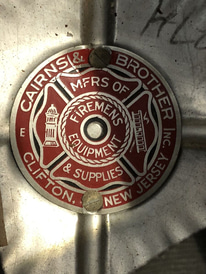Before Cairns - Henry T. Gratacap
Henry T. Gratacap, who many consider the father of the American fire helmet. Gratacap was an apprentice to William Hinton, who was a leather artisan and would also go on to make fire helmets. In 1836, Gratacap established his own business at 329 Broadway in New York. His company begin “making luggage for overseas voyages with specially treated leather for durability.” Gratacap was also a volunteer fireman with New York Fire Department and “in 1858 was foreman of the Columbian (Fire) Company.” He was well respected for his durable leather luggage that stood up to water and heavy use. Taking his artisan expertise and his real-world experience in fighting fires, he set out to design a true fire helmet that would protect the fireman and stand up to the fire environment. The Smithsonian American History Museum describes Gratacap’s creation as: A specially treated leather helmet with a segmented “comb” design led to unparalleled durability and strength. The elongated rear brim (also known as a duckbill or beavertail) and front piece were 19th-century innovations that remain the most identifiable feature of firefighters’ helmets. The body of the helmet was primarily designed to deflect falling debris, the rear brim prevented water from running down firefighters’ backs, and their sturdy crowns could aid, if necessary, in breaking windows.
The “comb” was a way to add strength to the helmet. A comb is basically a ridge formed on the outside of the helmet where two pieces come together and are sewn. This is how the rounded cone shape of the helmet crown is made with multiple pieces of shaped leather. Most common were four and eight comb helmets. So a construction feature became a valued design feature. Manufacturers also molded into the leather additional combs or ridges for shape, strength, or artistic design. In Duchesne’s book, Fireman’s Headgear in America 1658-1918, he reports that presentation helmets could have 148 to 180 combs.
Gratacap’s eight comb helmet with an elongated rear brim became known as the “New Yorker” style fire helmet. It was adopted by the New York Fire Department sometime in the 1800s, though a specific date was not identified. The volunteer New York Fire Department was organized in 1731 and lasted until 1865 when it was disbanded and a career department took over fire protection responsibilities.
Gratacap was also the first to develop the stitched or raised frontispiece and add a “finial” figure or “front holder” on the top front of the helmet to hold the top of the shield. The first finials were made of leather and later he teamed with the Cairns Company to produce brass finials that were more durable in holding the shield.
The Gratacap helmets can be identified by a number of accouterments or trim options. The front and side brim could be embossed or stamped with various vine patterns or floral motifs. The rear brim usually bore a complex design with “H.T. Gratacap” in the center and “New York” under it. Another variation included a date, all embossed within a horizontal oval. Of course due to Gratacap’s helmet popularity, his design and embossed embellishments were soon copied by a number of helmet makers adding minor variations and their own company’s name.
Gratacap’s company at one point in time was producing an average of 100 fire helmets a week. The cost at the time of a regular helmet was four dollars, and a fancy presentation helmet could run $75.16
Gratacap’s unique and durable style fire helmet were instrumental in setting the fire helmet standard of the day. However, it didn’t take long for other leather artisans and companies to follow suit and get involved in making and selling leather fire helmets. There were over 20 businesses making or selling fire helmets in New York during the 1800s. Philadelphia and Boston were listed as having quite a few helmet makers.
In 1869 after approximately 33 years of running his own business, Gratacap sold it to the Cairns brothers, Jasper and Henry.
Cairns & Brother
When the company was sold to Jasper and Henry Carins they had primarily been making badges and other metal identifying products. They had partnered with Gratacap about 1840 to produce the brass finials for his helmets before buying his helmet business outright in 1869. Cairns and Brother became one of the major fire equipment supply houses and fire helmet makers in the United States. Jasper and Henry Cairns were succeeded in the company by two more Cairns brothers, Edward and Irving. Later the company was headed by Walter Cairns, nephew of Irving.
The leather fire helmet business remained a core part of their fire equipment supply business as they grew over the years. The Cairns company (brothers Edward and Irving) had been making the brass front holders (finials) for the H.T. Gratacap helmets, and others for years before they bought Gratacap’s business in about 1869 and took over his shop at 143 Grand St, NY and continued at various locations within New York from 1869 until it moved to Clifton, New Jersey in 1945 (sometimes listed as 1948) under the direction of Edwin Cairns, grandson to one of the founders.
Those locations are;
143 Grand St, NYC (1869-1906)
186 Lafayette St/444 Lafayette St, NYC (1907-1933)
72 Grand St, NYC (1934-1945/48)
60 Webro Rd, Clifton, NJ (1945/48-Unknown)
A short walk away was John Olson’s shop where he too made helmets. However, he was not enthusiastic about it and combined with Cairns and Brother around 1930. In June of that year he was quoted in The New Yorker magazine article saying, “According to Mr. Olson, there isn’t much money in making firemen’s hats. They sell for eight dollars and seventy-five cents, and as it is all handwork the profit is small. Besides, they last so long—about ten years, on the average. Matter of fact, the only thing that keeps the shop busy is the business of repairing the eagles, which always coming in for regilding, refurbishing. For fixing eagles, the standard rate is one dollar.”
The shape of the “New Yorker” helmet has remained fundamentally similar through the years with the main differences coming along from the original higher dome to the “low type” in about 1937 when the leather dome was shortened and the old “high eagle” was relegated to an option and no longer the standard. By this time they were offering 3 different types of leather helmets and 3 types of aluminum helmets. The medallions on the underside of the dome began lettering in 1966 and were lettered until 1986 when the N5A with impact cap was introduced. At this time the N5A had a tan impact cap but once the N6A Houston (NFPA certified helmet) was released the impact cap in the N5A was black and the impact cap in the N6A is grey.
Aluminum helmets like the Senator, Derby, Drop Brim (commonly mislabeled a “war baby”), and Streamliner for a were produced from the late 1880s all the way up through the late 1960s/early to mid 1970s when other materials began taking over the market.
Fiberglass and later Kevlar helmets such as the Flint Flex, and 900 Clifton began production in the late 1950s but eventually gave way to lexan then eventually thermoplastic. Fiberglass traditional style helmets are now offered in the form of the 1010 and 1044.
In the early 1970s two lexan helmets were released, the 770 Philadelphian and the 880 Century which shared the same interior components. The 880 remained largely the same until it was discontinued and remains fairly similar after its re-release as the 880 Tradition. The 770 evolved into the 600 series which is now the 660 Metro which still resembles the 660 though wider because of the impact cap.
Excerpt from July 1936 Fire Engineering Celebrating 100th Anniversary
Write your text here...
CAIRNS & BRO. CELEBRATES 100th ANNIVERSARY
Carefully preserved in the office of Cairns & Brother, now located at Lafayette Street and Astor Place, New York, is a certificate dated 1829, testifying to the fact that Henry T. Gratacap “is one of the firemen of the City of New York.” Those were the days of watch towers, leather buckets and hand pumpers, when firemen wore high hats of felt and paper or “leather caps.” The Firemen of the New York City Volunteer Department were ordered to wear leather “caps” as early as 1813. The purpose of the cap was to designate their membership in the department, but Mr. Gratacap soon saw the necessity for something that would give protection as well.
In 1836 he set up a small shop at Broadway and Walker Street, New York for the purpose of manufacturing firemen’s helmets, and thus founded the business which is now, and has been for many years past, known as Cairns & Brother.
Search of early records indicates that one Jacob Turk made a “leather fire cap” as early as 1740, but Mr. Gratacap is credited with being the first to make the hardened leather fire helmet with enlarged brim, and also with being the first to decorate the helmet with the brass eagle head, a style which is traditionally known as the American Regulation. The fundamentals of his design are found in the most popular models today, though many improvements have since been made. The demand for this helmet grew, soon making larger quarters necessary, and when Mr. Gratacap moved to 143 Grand Street in 1850 his friends freely predicted that to go so far “uptown” would be ruination. On the contrary his business prospered, and in 1869 he sold out to two Cairns brothers, Jasper and Henry. They in turn were succeeded by two more Cairns brothers, Edward and Irving. Irving survives and at 84, is still active in the business. His successor is a son Edward, and associated with the firm for nearly 50 years is a nephew of Irving, Walter.
The firm name Cairns and Brother remains unchanged and is favorably known to firemen of the U.S.A., Canada and many other foreign countries. Their entire career has been devoted to the manufacture of firemen’s equipment, specializing in helmets, and while the business never reaches large proportions (mainly because of the long life of the product), the firm’s record of continuous operation for a century is tribute to energetic and honest management.
The trademark of the firm is a fireman striding through flames, with trumpet held aloft and a child in his arms. Standing in the firm’s office is a wooden statue of this trademark, three feet high, wearing a miniature helmet with his breast adorned by a solid gold badge. The figure was hewn from solid oak by an old carver of figure heads for sailing vessels in old times. This man whose name is not known, was one of a group of volunteer firemen who for many years came daily to the old Gratacap shop and spent hours in talk, playing cribbage and smoking. An interesting reference to this group is found in an early history of the Volunteer Fire Department of the City of New York. “A certain place in Grand Street, neither a cigar store nor a rum shop, where fire laddies wont to congregate,” and said Mr. Gratacap, “blow fire-talk from daylight until ten at night. I gave them tobacco and water, but no liquor.


